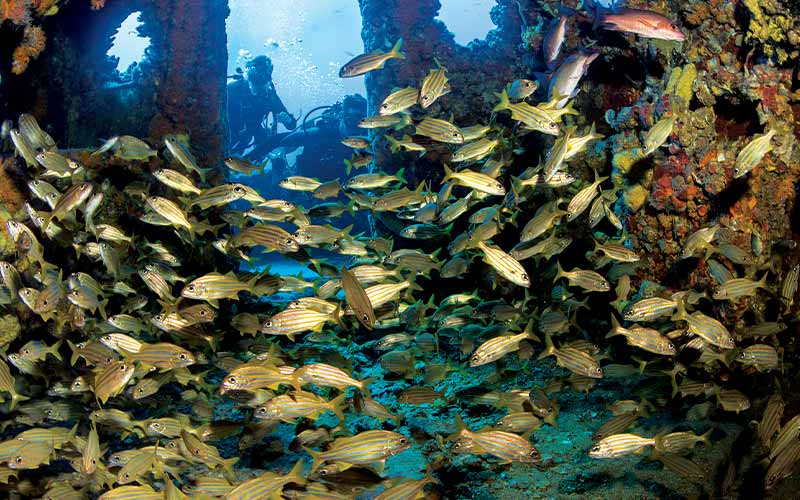It’s hard to believe a quarter-century has passed since the U.S. Coast Guard cutters Bibb and Duane were sunk off the south end of Key Largo, Fla. But a dive on these wrecks today reveals a vibrant cloak of orange cup corals, encrusting sponges and other marine life that clearly confirms the passage of time.
It was the day after Thanksgiving in 1987 when the USCGC Duane slipped beneath the waves to land perfectly upright in 125 feet of water, its bow jutting proudly into the current. It was a textbook success in the world of reefing ships. The next day the Duane‘s sister ship, USCGC Bibb, was sunk using the exact same method. By whatever vagaries influence this rather inexact science, the Bibb landed on its port side. The ships are 327 feet long and were built for speed, which means their beams are a relatively narrow 40 feet. Since the Bibb came to rest on its side, it became a much deeper dive site at 90 to 130 feet.
The Duane makes for an excellent multilevel dive; divers can explore the propellers on the seafloor, the stern deck at 107 feet, the wheelhouse at 90 feet and then ascend along the radar tower, which rises to within 40 feet of the surface.

The Duane is the more popular of the two wrecks by far, and though it may be shallower, it has its challenges as well. Typically these exist in the form of the Gulf Stream currents that rage so fiercely at times that the site’s three mooring buoys are pulled underwater. On those days a prudent captain will head north a few miles and may find entirely different conditions waiting on what has become the king of Key Largo wreck dives, the 512-foot USS Spiegel Grove. But on those special days when the current is minimal and visibility reaches 120 feet, there may be no better wreck dive anywhere in the Western Hemisphere than the Duane.
The waters that wash over the wreck nourish an astoundingly colorful array of filter feeders. Turtles rest in the radar tower, and formations of barracuda cruise along the mooring lines. Massive schools of grunt clog the wheelhouse, while huge tarpons and Caribbean reef sharks appear frequently. Because it is at the heart of a pelagic pathway, even whale sharks and mantas may be seen.
The Bibb and the Duane were donated to the Florida Keys by the U.S. Department of Transportation’s Maritime Administration (MARAD), but they still had to be cleaned of contaminants and towed from Boston to Key Largo. Such things are very expensive today; it cost $1.2 million to sink the Spiegel Grove in 2002 and closer to $10 million to sink the USS Vandenberg off Key West in 2009. The USS Oriskany, sunk off the Florida Panhandle in 2006, is the grand champion of artificial reef extravagance, costing more than $20 million. The Bibb and the Duane were sunk for just $300,000; they are gifts that keep on giving to wreck-diving enthusiasts in the Florida Keys.
© Alert Diver — Q4 Fall 2012